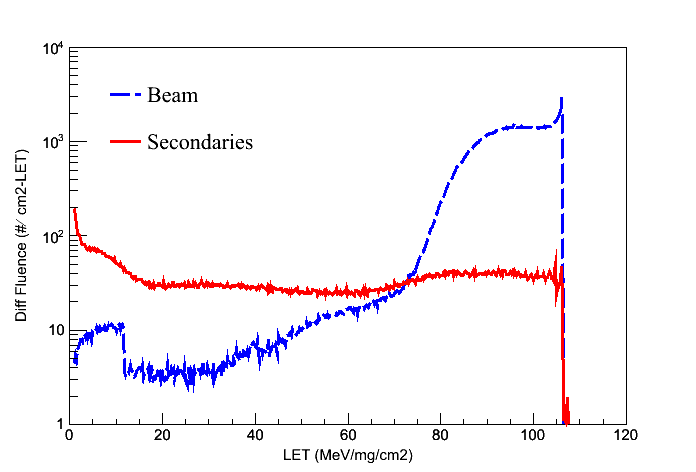Date: Thu, 15 Nov 2012 09:19:56 -0600
Thank you Stefan.
I am looking at the LET distribution of beam particles and secondaries produced near the Bragg Peak in silicon. In this case, near the Bragg Peak is at a position just prior to the stopping point, so that there are some BEAM particles included in the distribution, and their elastic components. FLUKA shows the Bragg Peak around an LET of 93 or so (produced in a different simulation), in units of MeV/mg/cm2, which is consistent with other sources. What I don't understand, is if I look at the USRYIELD from BEAMPART and ALL-PART, and assume the secondary particle distribution is (All-PART - BEAMPART), I get the attached graph. Below, are my USRYIELD card entries.
*
USRYIELD 2623.0 201.0 -47.0 LAYER2 LAYER3 1.0LET1
USRYIELD 12000.0 0.0 500.0 1.0 0.0 1403.0&
*
USRYIELD 2623.0 210.0 -48.0 LAYER2 LAYER3 1.0LET1
USRYIELD 12000.0 0.0 500.0 1.0 0.0 1403.0&
*
It seems that the BEAMPART must include other secondaries. Au in Silicon maximum LET=93 (MeV/mg/cm2) (approximately), but the FLUKA data shows it clearly going out to LET=107 MeV/mg/cm2. It seems that the higher LETs are of particles produced by the nucleus of the Au and Si combined. The max LET of a Silicon ion is about LET=14 MeV/mg/cm2, and their combination (Au + Si = 93+14=107 MeV/mg/cm2) is almost exactly what the USRYIELD data is showing. I know one can't directly add the two together, but this should be a close estimate of what the maximum LET could be produced in this interaction.
So, I guess my question is what is producing the high LET particles in the BEAMPART USRYIELD data?
Brandon
-----Original Message-----
From: owner-fluka-discuss_at_mi.infn.it [mailto:owner-fluka-discuss_at_mi.infn.it] On Behalf Of Stefan Roesler
Sent: Thursday, November 15, 2012 3:05 AM
To: REDDELL, BRANDON D. (JSC-EV511)
Cc: fluka-discuss_at_fluka.org
Subject: Re: clarification of BEAMPART LET output
Dear Brandon
BEAMPART refers to particles of generation 1 (e.g., as recorded in array LOFLK in the stack). These are beam particle, including elastically scattered ones as elastic scattering does not increase the generation number.
Cheers
Stefan
On Tue, 13 Nov 2012, REDDELL, BRANDON D. (JSC-EV511) wrote:
>
> Dear FLUKA experts,
>
> I have a question when using USRYIELD to get LET for BEAMPART only
> (particle id=210). The output gives a nice LET distribution. I?m
> confused on what exactly is included in this double differential, can
> someone tell me what below item is included in the output?
>
> 1) Only primary beam particles (does not include any elastic or inelastic ions
> of the same Z and A as the beam)
>
> 2) Or all particles with the same Z and A as beam (which includes primary and
> secondary elastic or inelastic ions of the same type as beam)
>
> 3) Or something different
>
> If it is option 3, please elaborate!
>
> Your clarification is much appreciated,
>
> Brandon
>
